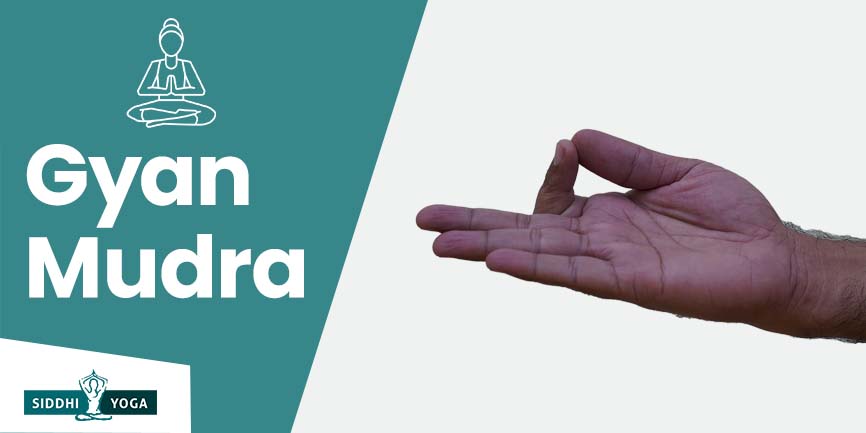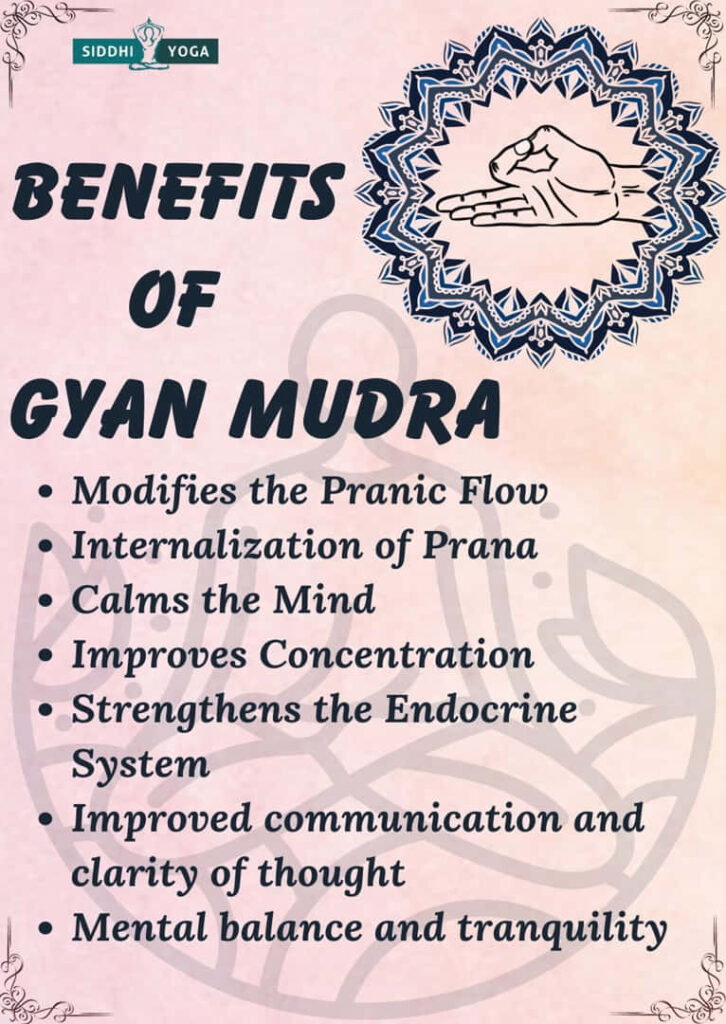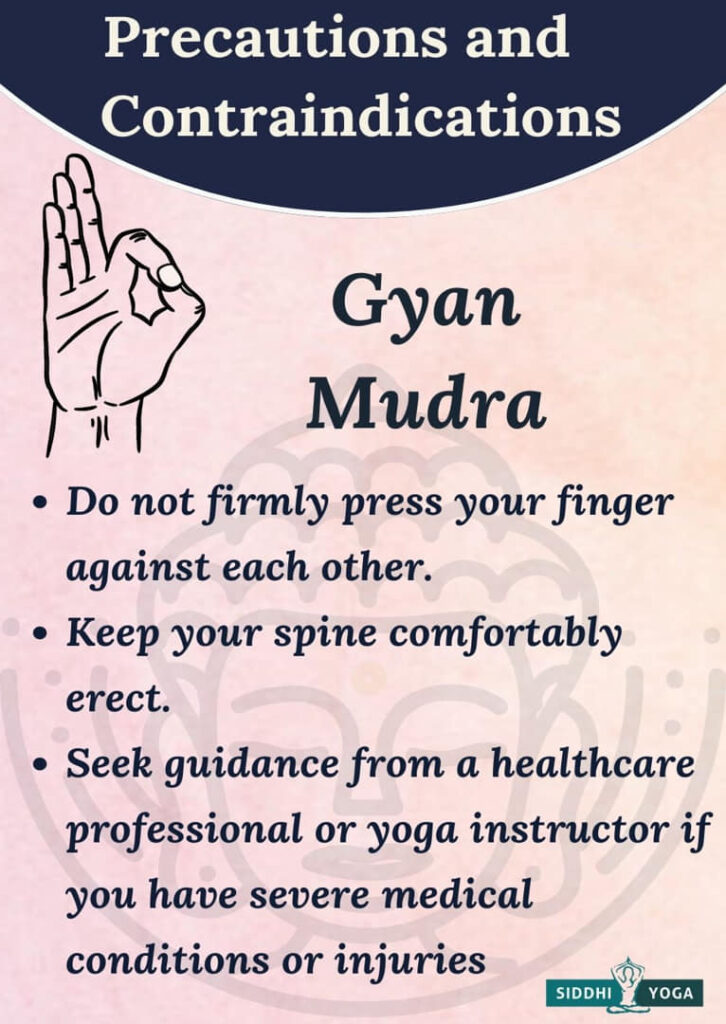
Learn about the meaning of Gyan Mudra and its benefits for both body and mind. Discover how to do this simple yoga pose in easy steps.
Definition – What is Gyan Mudra and its Meaning, References, and Mythology?
Gyan Mudra or Jnana Mudra is one of the most important Mudras. It is a type of Hasta Mudra (Hand gesture or seal). It is quite simple to do and quite easy to understand. One such Mudra can be practiced at any time, anywhere.
If you look at various Hindu mythological texts and sculptures, you will find them almost everywhere.
If we break down the literal meaning of this Mudra, then we will get:
Gyan – Knowledge or Wisdom.
Mudra – Hand gesture or seal.
So, this Mudra is best for those looking to attain wisdom. When you want to do something, you start by sending a signal to this entire universe. This sets an intention to this universe that there’s someone who is looking for wisdom. Gyan Mudra is a Mudra. By practicing this, you can attain great knowledge. This universe will start to bring whichever knowledge you require.
Those who want to follow a yogic life should assume this Mudra while practicing Asanas, Pranayama, or Meditation, as it refers to the knowledge of enlightenment wisdom of yogi.
Vayu & Agni together control the mind. Vayu causes movement & thoughts. Those who have a high Vayu (Air) element speak faster. You will observe a lot of movement around them. Agni affects the functioning of the brain. Together they stabilize the mind.
Gyan Mudra stimulates the pituitary gland. The pituitary gland is known as the master gland. It controls many important functioning of our body. A person’s physical structure, height, etc., depends on the pituitary gland. So, practicing Gyan Mudra can improve many things at once.
Improves the functioning of our senses. As we already know, from our mood to important body functions many important things are carried out by our hormones. It helps to maintain the balance of different hormones.
Alternate Name of Gyan Mudra
Jnana Mudra.
How to Do Gyan Mudra?
- Although you can practice this while practicing any comfortable posture, to achieve a proper result and concentration, we should practice it in a comfortable meditative posture.
- We will start by sitting in a comfortable meditative posture, for example, Lotus Pose (Padmasana) and Auspicious Pose (Swastikasana).
- The neck and spine should be comfortably erect.
- Entire awareness should be focused on the breath.
- Place your hands comfortably on your knees.
- Keep your palms facing upward towards the sky.
- Now, slowly and gently join your index finger and thumb.
- This way, you create a circle in both of your hands.
- Keep the remaining fingers comfortably extended.
- Slowly & comfortably close your eyes.
- Bring your awareness to the breath and breath as deeply as you can
- Now, if you feel comfortable, you can also add om mantra chanting for deeper concentration.
Also See: 200 Hours Online Yoga Teacher Training
Gyan Mudra Benefits

- It modifies the pranic flow. Generally, our prana leaks through our extremities (Hands & Legs). By practicing this Mudra, we can redirect the Pranic flow towards the other body parts. More pranic circulation means more lively you will feel.
- The internalization of prana. As it redirects the pranic flow, it helps avoid leakage of pranic energy.
- It calms the mind. This is something that you should witness all by yourself. Just sit comfortably in any comfortable seated posture and practice Gyan Mudra for 20-30 mins. Now, witness the difference. How did you feel when you first started your practice? And how do you feel now?
- It improves concentration.
- If you are looking to start your spiritual journey, then it is one of the Mudras that you will find easy to practice and concentrate on.
- It strengthens the endocrine system & the muscular system.
Gyan Mudra Precautions and Contraindications

Similar to all other Mudra practices, it has no side effects.
However, there are a few things to consider:
- Do not firmly press your finger against each other. They should be slightly touching each other and not put excessive pressure.
- Keep your spine comfortably erect.
When and how long to do Gyan Mudra?
This Mudra can be practiced whenever you feel you are lacking focus. Especially those days when you feel dull. You feel that you lack courage and energy.
Morning is the ideal time to do any yoga or Mudra. In the morning, at this time during the daytime, our brain is at its best. So, you are more likely to be able to concentrate easily. Therefore, you should practice this Mudra from 4 am and 6 am to get the most effective outcomes.
If you are having difficulty with this during the morning, you can do this Mudra later in the evening too.
Practicing this Mudra for a minimum of 30-40 minutes daily is recommended. Whether you wish to complete it in one stretch or two threes that last between 10 and 15 minutes, it’s up to you. Based on research, the best way to practice an exercise for at least 20 minutes is to get the best benefits of that particular Mudra.
Breathing in Gyan Mudra
- Yogic Breathing can be practiced along with Gyana Mudra.
Visualization in Gyan Mudra
Visualize that your body is receiving wisdom from its surroundings in the form of tiny white sparkling stars.
Affirmation in Gyan Mudra
While practicing this, Keep a positive intention. Start with:
“I dare to face whatever my life has to offer.”
Conclusion
The Gyan Mudra is among the most popular and well-known Mudras or hand gestures. This Mudra is often used in meditation and yoga practices, as it is said to promote concentration and peace of mind. This Mudra represents knowledge, wisdom, and self-realization. The benefits of the Gyan Mudra include reducing stress and anxiety, improving concentration and memory, boosting immunity, and promoting overall health and well-being. If you’re interested in learning more about Mudras and how to use them for your benefit, consider enrolling in our Mudras Certification Course. This course provides comprehensive instruction on all 108 Mudras, their meanings, and how to use them effectively for maximum results.
Responses